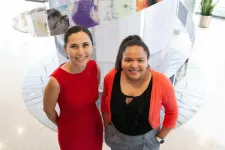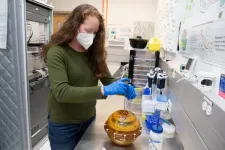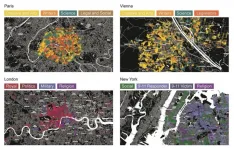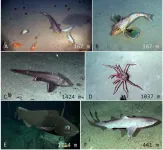(Press-News.org) Despite unprecedented advancements in technology and countless depictions of complex human-AI interactions in sci-fi movies, we have yet to fully achieve AI bots that can engage in conversation as naturally as humans can. Kushal Chawla, researcher at the USC Institute for Creative Technologies (ICT) and a doctoral student in computer science, along with collaborators at both the USC Information Sciences Institute (ISI) and ICT are taking us one step closer to this reality by teaching AI how to negotiate with humans.
The research, presented at the 2021 Annual Conference of the North American Chapter of the Association for Computational Linguistics (NAACL) this month, relied on a scenario-based dataset that was collected to teach negotiation skills to human users through role-play dialogue. With a campsite setting as the imaginary backdrop, participants in the data collection study were instructed to interact with each other as if they were campers negotiating for resources. The researchers discovered a total of nine strategies that the participants utilized throughout the exercise. The stand out lesson: cooperative strategies of negotiation were more effective than selfish strategies. This information can be used in the future to inform the creation of an automated system which takes various strategies of negotiation into account.
Training AI
CaSiNo, which stands for Camp Site Negotiations, is a scenario-based dataset that was collected to teach negotiation skills to human users through role-play dialogue.It consists of over a thousand negotiation dialogues which are carried out by two participants at a time. At the core of these dialogues, there are three essential camping items that the participants negotiated for -- food, water, and firewood. Each participant is assigned a preference order for these items and negotiates based on this model. As the participants negotiate with one another, they come to conclusions about how to allocate the items to best maximize each person's rewards.
Prior to these dialogues, participants underwent a training module which consisted of watching a video tutorial on negotiation. Doing so allowed participants to understand best practices of negotiation to be incorporated into the performance.
"We evaluate the negotiation performance of the participants in three ways: final points scored depending on what they were able to negotiate for, how satisfied they were with the outcome, and how much their opponents like them," explained Chawla. "All these metrics are crucial in the context of real-world negotiations."
Standing Out
Chawla has extensive prior research in AI, but CaSiNo is his most ambitious approach yet.
"One difference with these prior works is that in these cases, the negotiations don't involve language-based communication, but rather are based on button clicks and drop-down choices in a menu," explains Chawla. "However, our work on the CaSiNo dataset would promote the development of AI systems that can negotiate using language (such as in English) and have real, rich conversations with humans."
Similarly, most work in the field of automated negotiation systems has been focused on a menu-driven interface rather than language-based communication. Though these technologies have been easy to navigate, Chawla argued that "they fail to capture free-form emotion and persuasion, which are key components of real-world negotiations." Language, on the other hand, encapsulates human-like characteristics that help ground AI communication in the real world.
Achieving this new level of AI communication requires construction of complex negotiation datasets through which AI can be trained. It can be a challenge to construct the perfect dataset -- prior efforts at doing so have often been either too restrictive or too open-ended. In order to find the perfect balance between the two, Chawla and his team approached this challenge by "proposing a novel task that enables linguistically rich and personal conversations, but still in a constrained environment."
Applications in Pedagogy and Beyond
As an effective way of automating negotiation instead of relying on humans, it's no wonder CaSiNo has a variety of real-world applications. This technology can be applied to various industries, including business, education, entrepreneurship and tech. Specifically, CaSiNo can help with teaching negotiation skills in various pedagogical contexts, whether it be training business students to secure deals or helping lawyers to assess settlement rates more accurately.
CaSiNo is also highly valuable for improving negotiation skills of conversational AI assistants. Chawla mentions the Google Duplex prototype as an example, in which AI assistants express negotiation skills to automatically make appointments over the phone.
Future Directions
Going forward, Chawla and his team are broadly interested in looking deeper into other types of non-collaborative dialogue outside of negotiation, such as persuasion. Non-collaborative dialogue is generally defined as communication "where the goals of the involved parties may not perfectly align with each other."
More specifically, Chawla outlines two directions of future research based on the current work with CaSiNo. Firstly, the team is interested in looking at the predictive capabilities of AI through how emotional expression in CaSiNo dialogues correlates with the outcomes of negotiation. By doing so, these AI agents can be improved to become more emotion-aware. Secondly, the team is looking to improve the believability of negotiation skills by building upon realistic free-form language training. Ultimately, CaSiNo is a groundbreaking system that will serve as a solid foundation for improvements in human-computer interactions.
INFORMATION:
Although cardiovascular disease is the main cause of illness among women in the U.S., certain conditions such as coronary microvascular disease (CMD) cannot be easily diagnosed. In a new study, researchers at the University of Illinois Urbana-Champaign have identified specific biomarkers for CMD, which might reduce future hospitalizations.
CMD damages the inner walls of blood vessels causing spasms and decreased blood flow to the heart muscle. "Clinicians look for plaque formation in the blood vessels, which does not occur in CMD," said Zeynep Madak-Erdogan (CGD/EIRH/GSP), an associate professor of nutrition. "Usually, ...
The virus that gives rise to COVID-19 is the third coronavirus to threaten humanity in the past two decades. It also happens to move more efficiently from person to person than either SARS or MERS did. The first African case of COVID-19 was diagnosed in Egypt in mid-February of 2020. Four weeks later, the first lockdowns began across Africa. Steven Schiff, Brush Chair Professor of Engineering at Penn State, who already had established research partnerships in Uganda, saw an opportunity for his team to apply what they were learning from their ongoing efforts to track and control infectious disease and ...
Ten estuaries on the West Coast of North America have been identified as priority locations for expanding the use of conservation aquaculture in a study led by the Native Olympia Oyster Collaborative and funded by the Science for Nature and People Partnership (SNAPP). SNAPP is a research collaboration supported by the National Center for Ecological Analysis & Synthesis (NCEAS) at UC Santa Barbara.
The study, published in Plos One, recommends locations and methods for the strategic expansion of conservation aquaculture to bring back Olympia oyster populations -- both to local estuaries where they have most declined, and into more local restaurants for oyster lovers to dine on. The authors propose using aquaculture in these estuaries -- ...
Even the mundane act of swallowing requires a well-coordinated dance of more than 30 muscles of the mouth. The loss of function of even one of these, due to disease or injury, can be extremely debilitating. For these people, nerve stimulation offers a ray of hope to regain some of their lost oral function.
In a new study, researchers at Texas A&M University have delineated the minimum size of electrical currents needed to provide sensation in different parts of the mouth. The researchers said their study is a first but vital step toward building electrical stimulation implants that can restore essential intraoral functions that are lost due to nerve or brain damage.
The results of the study are published in the journal ...
Magnetic resonance imaging (MRI) is widely used in medicine to detect, diagnose and treat diseases such as cancer, while relying on experts' interpretation of images. Quantitative MRI, which obtains numerical measurements during the scans, can now potentially offer greater accuracy, repeatability and speed -- but rigorous quality control is needed for it to reach its full potential, according to a new study.
Researchers at the National Institute of Standards and Technology (NIST) led the study by 11 institutions comparing measurements by 27 MRI scanners from three vendors at nine clinical sites around the country. To obtain reference values and disentangle sources of bias and variation, the study used a tissue stand-in, or "phantom," originally ...
A city's street names can provide a glimpse into its cultural value system and a way to quantify cultural indicators, according to a study published June 30, 2021 in the open-access journal PLOS ONE by Melanie Bancilhon from Washington University in Saint Louis, U.S., and colleagues.
Ever since named streets have existed, they have been used as a form of social engineering, mirroring a town or city's social, cultural, political, and religious values. Building off this concept in what they term "streetonomics," Bancilhon and colleagues used street names as an alternative route to quantify cultural indicators in four influential Western cities: Paris, Vienna, London, and New York.
The authors used multiple open data sources ...
The deep sea Pacific Salas y Gómez and Nazca ridges are highly biodiverse and host unique fish and invertebrate taxa, according to video surveys.
INFORMATION:
Article Title: Deep-sea biodiversity at the extremes of the Salas y Gómez and Nazca ridges with implications for conservation
Funding: The expeditions were funded by the National Geographic Society and Pristine Seas donors with support to AMF. Conservation International, the Paul M. Angell Family Foundation, Tom and Currie Barron, and Alan Eustace provided additional support to DW, WG and JG. The Chilean Millennium Science Initiative Program grant #NC120030 ...
In the German population, a surprisingly high 6% of under-18s are at risk of cognitive decline, falls and more from the cumulative effect of anticholinergic medications such as antihistamines and antidepressants.
INFORMATION:
Article Title: Anticholinergic burden: First comprehensive analysis using claims data shows large variation by age and sex
Funding: The authors received no external funding for this work.
Competing Interests: UH, OR, MB and JR are working at an independent, non-profit research institute, the Leibniz Institute for Prevention Research and Epidemiology - BIPS. Unrelated to this study, BIPS occasionally conducts studies financed by the pharmaceutical industry. Almost exclusively, these are post-authorization ...
Researchers have developed and successfully demonstrated a novel method for studying how cells repair damaged DNA in space. Sarah Stahl-Rommel of Genes in Space and colleagues present the new technique in the open-access journal PLOS ONE on June 30, 2021.
Damage to an organism's DNA can occur during normal biological processes or as a result of environmental causes, such as UV light. In humans and other animals, damaged DNA can lead to cancer. Fortunately, cells have several different natural strategies by which damaged DNA can be repaired. Astronauts traveling outside of Earth's protective atmosphere face increased risk of DNA damage due to the ionizing radiation ...
An important function of our vision is to segregate relevant figures from the irrelevant background. When we look at a visual stimulus, it drives a cascade of neural activity from low-level to higher level visual brain areas. The higher areas also provide feedback to the lower areas, where figures elicit more activity than the background, as if figures in the brain are highlighted with extra activity. Researchers from the Netherlands Institute of Neuroscience (NIN) now showed that feedback causes the extra neuronal activity in low-level areas and that the extra activity is essential for figure-ground ...







